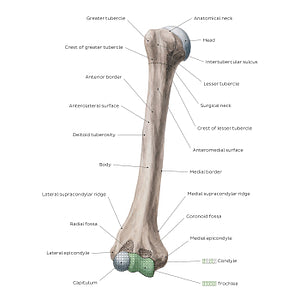Yousun Koh
Humerus: Anterior view (English)
Humerus: Anterior view (English)
The proximal end of the humerus is composed of a large rounded head, an anatomical neck and a surgical neck. Located towards the lateral portion of the proximal humerus is a bony protrusion known as the greater tubercle. The greater tubercle has an anterior and posterior surface. The lesser tubercle is much smaller than its greater counterpart and is situated more medially. These prominences act as an important attachment site for the muscles of the shoulder. Both the greater and lesser tubercles extend distally into crests and demarcate a prominent groove called the intertubercular sulcus. This sulcus consists of a lateral and medial lip, which function as insertion sites for the latissimus dorsi and pectoralis major muscles. The intertubercular sulcus also acts as a conduit for the tendon of the long head of the biceps brachii muscle and is therefore also known as the bicipital groove. The anterior shaft of the humerus is marked by the deltoid tuberosity, which provides an attachment point for the deltoid muscle. From this anterior perspective, two borders (anterior and medial) and two surfaces (anteromedial and anterolateral) of the humerus can be identified. The distal end of the humeral shaft widens to form the medial and lateral supracondylar ridges, which end distally as the medial and lateral condyles of the humerus. The medial and lateral epicondyles act as important attachment sites for muscles of the forearm. The distal end of the humerus is marked by a series of fossae and processes. The condyle of the humerus is made up of the articulating trochlea and capitulum and non-articulating olecranon (see next image), coronoid, and radial fossae. The condyle of the humerus plays a key role in the formation of the elbow joint as it articulates with the radius and ulna.
Preço normal
$7.56 USD
Preço normal
Preço promocional
$7.56 USD
Preço unitário
por
Não foi possível carregar a disponibilidade de retirada.


#6D8E6F
#4C443C e #B1C9AB

